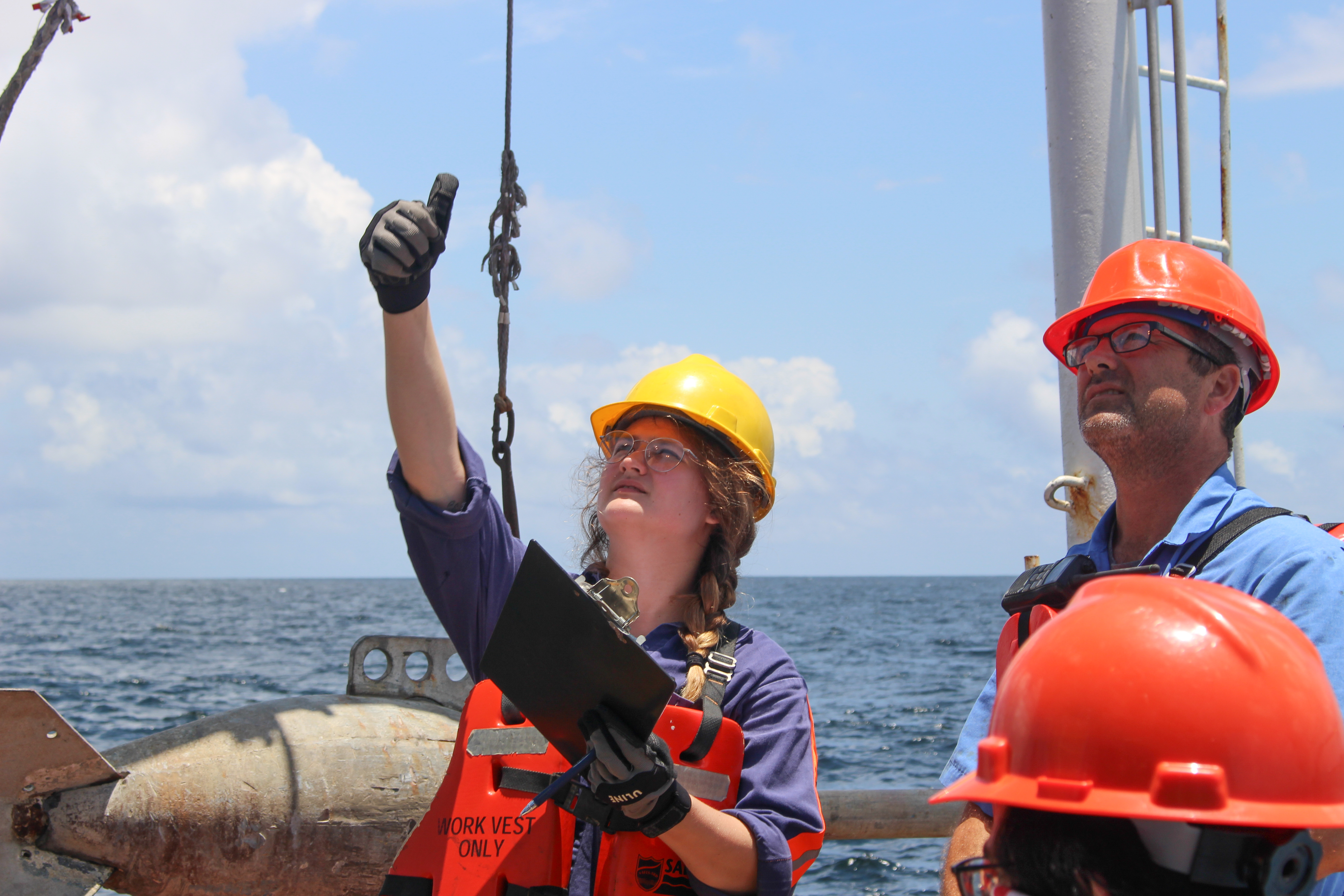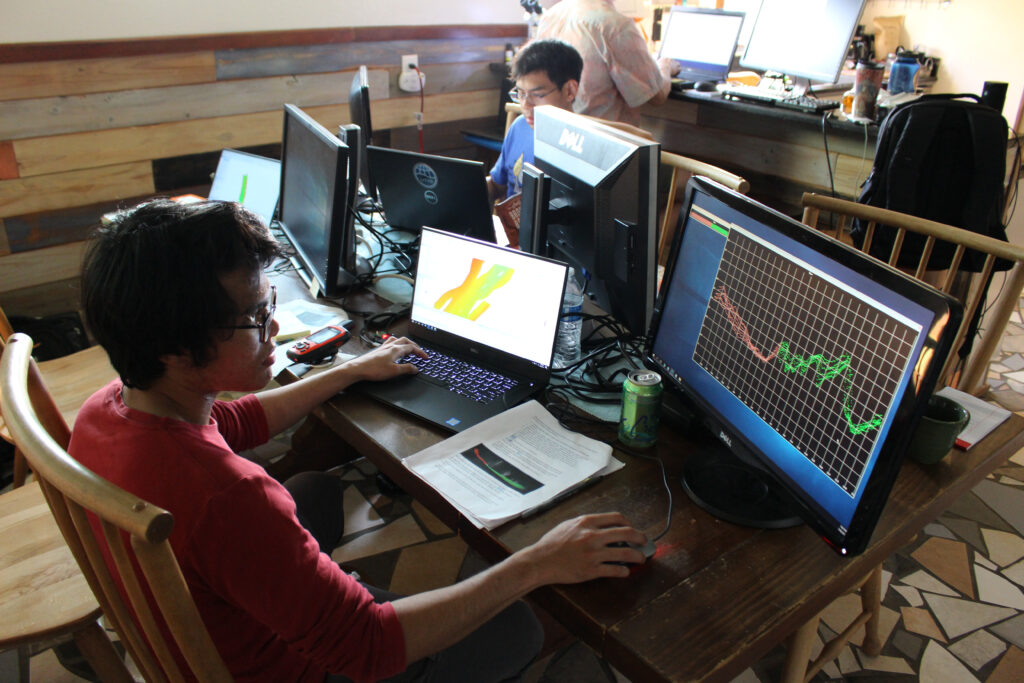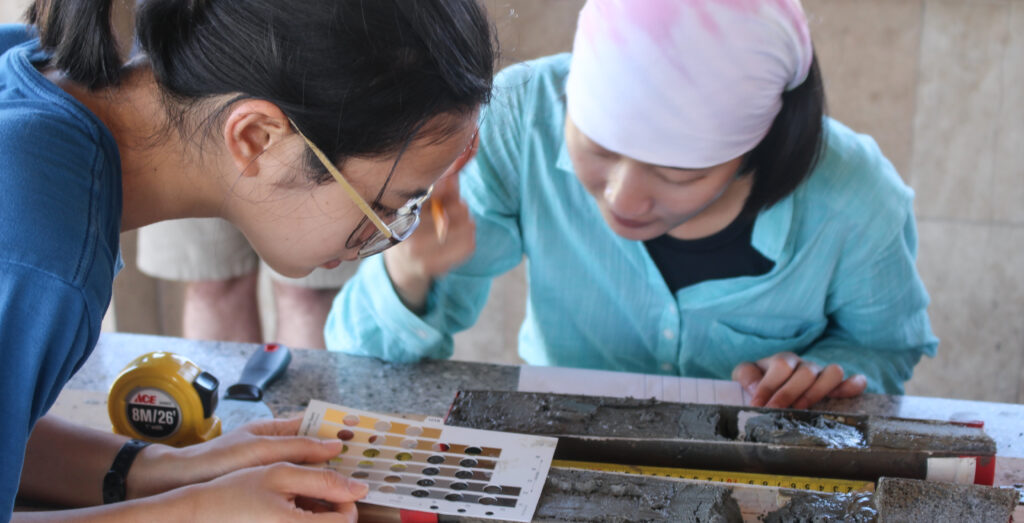
Each Maymester (between spring and summer semesters), the University of Texas Institute for Geophysics (UTIG) at the Jackson School of Geosciences, offers a three-week field course that provides hands-on instruction in the collection and processing of marine geological and geophysical data, including a week conducting at-sea investigations of coastal processes in the Gulf of Mexico.
This year the course is in danger due to a funding shortfall. We need your help to raise $10,000 and make the 2020 Marine Geology and Geophysics Field Course a reality.
Join the MG&G HornRaiser now!

Matt Janecka has just finished lowering a type of seismic imaging device known as a chirp into the water off the side of the R/V Scott Petty. The stabilizing fins of the sleek, delta-shaped instrument are not unlike some of the airborne equipment Matt has worked with for his aerospace engineering master’s. According to Matt however, the similarities are more than just their streamlined appearance.
“The chirp, multibeam and sidescan sonar actually use similar principles to what you’d find in aerospace for navigation or scanning,” he said.
Matt explains that by towing the chirp behind the research vessel he can trace layers of ancient riverbeds and sandbanks in the first few hundred feet beneath the seafloor.
The chirp, which emits rapid pulses of sound at different frequencies to create high resolution images of the subsurface, is one of several pieces of advanced science equipment Matt and his fellow UT students are learning to use on the UT Marine Geology and Geophysics Field Course. Although a field course by name, the week-long trip to the Texas coast is for all intents and purposes a condensed science expedition. That’s because the field course is not simply an educational experience for the sixteen students who take the course each year: it’s an opportunity to conduct real science, mapping the effect of major storms on the coastline or searching for signs of ancient river valleys buried in the Gulf of Mexico.

Sadly, the future of the course is under threat because of a funding shortfall. Nikki Bretting, a recent graduate from the UT Jackson School of Geosciences who took the course in spring 2019, said that losing the course would be a setback for science and education in Texas.
“I came to the course expecting another geology field camp,” said Nikki. “But it blew my expectations out of the water. I learned more in one week than I did in any of my other classes.”
In just a few short days, Nikki and her classmates took cores from a marsh, studied fossil remains of microscopic organisms for signs of past climate change, hauled dumpster-sized seafloor samples onto the deck of a heaving ship, scanned the seafloor with sophisticated sonar and seismic imaging equipment.
“I feel like I could take my experiences on the field course and apply them to really anything that I go into,” she added.

Back on dry land, Arisa Ruangsirikulchai is carefully studying sections of a nine-foot long sediment core from the Gulf of Mexico which she helped gather the previous day on board the R/V Brooks McCall. The large research vessel allows the students to deploy much larger instruments in deeper water including the large, heavy piston core that allowed them to gather the sediments. Arisa says the sediments reveal centuries of coastal evolution, including signs of major storms and flooding events. It also fits in well with the subject of her senior thesis which focused on Hurricane Harvey’s impact on the beaches of nearby San Jose Island. Despite spending years studying this kind of data, this is the first time she’s been exposed directly to the techniques used to gather the data.

“UT trusts us to take charge of instruments worth hundreds of thousands of dollars and work in a team to get the task accomplished,” said Arisa. “It’s unique and I think it’s a much faster way to learn.”
As an educational and career building experience, the MG&G field course is second-to-none and attracts students from all physical sciences. Keeping the course at such a high standard is expensive, however. As well as the seismic and sonar instruments, coring tools and lab equipment, the course also requires the use of deep water research vessels such as the R/V Brooks McCall.
Head instructor Sean Gulick said that hiring a research vessel large enough to conduct full-scale marine geoscience is a significant expenditure. “The Brooks McCall costs around $10,000 per day,” said Gulick, who is also a UTIG Research Scientist and Professor at the UT Jackson School of Geosciences. “But the value for students to use expeditionary science equipment in the field far exceeds the monetary cost of running the course each year.”
Nonetheless, funding the course is a significant challenge for the scientists who organize the field course. According to Gulick, the course would never have existed were it not for the generosity and vision of organizations and individuals willing to keep the course alive.

For the 2020 cohort, the field course is currently short $10,000, or about the cost of hiring the Brooks McCall for one day. Without this money, the course would lose one of its core educational and scientific pillars and would likely be cancelled. Sixteen students next year would miss out on a career-shaping expedition into the field and a highlight of their UT experience.
That’s why this year, the MG&G Field Course has turned to HornRaiser, UT’s own online crowdfunding platform, to meet the shortfall and keep the course afloat. From November 6 to December 6, the MG&G Field Course HornRaiser campaign hopes to raise $10,000 through online donations from students, faculty members, staffers and all friends of the Forty Acres.
We need your help to make the 2020 Marine Geology and Geophysics Field Course a reality.
Give now. Visit https://hornraiser.utexas.edu/supportMGG.
